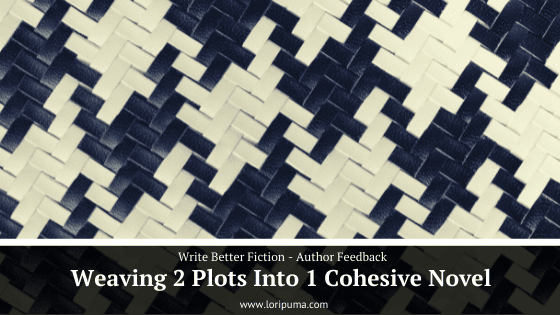Write Better Fiction: Keeping Readers Hooked in Crime Novels
/Wanna keep readers hooked on your mystery or thriller? See where great plot twists come from in this sci-fi crime novel example.
This month’s example comes from Jerome Koch. He’s writing a 100k word science fiction novel. He would specifically like to know how to: “Write a riveting story that keeps the reader hooked.”
Here’s how Jerome describes the premise of his novel:
FBI agent, Pam Harris, attempts to make sense of a murder, only to be drawn into a nightmare she cannot imagine. The arrest of the murder suspect, John Taylor, is only the beginning of a search for a monster that that may change life on earth as we know it.
This is a great premise with a lot of potential for action. Jerome described this story as a sci-fi mystery. However, I’d call this story a sci-fi thriller, based on the current premise. Mysteries and thrillers share many common traits, but what keeps readers hooked on the story is slightly different in a mystery versus a thriller. Before we get into the specifics of how Jerome can keep his readers hooked, let’s talk about what readers are looking for in each genre.
What hooks readers in mysteries versus thrillers
A mystery is about who committed a crime, why they committed the crime, and the efforts to bring the villain to justice. In a mystery, the author creates a puzzle for the readers. While the author is always truthful in sharing the details of the sleuth’s investigation, they use several strategies—multiple suspects, false clues, misinterpreted evidence—to mask the identity of the true villain. What keeps readers hooked on a mystery is the challenge of figuring out who the true villain is before the author reveals the truth in the story's climax.
Thrillers are NOT about who committed a crime. The question in a thriller is: “Can the protagonist stop the threat posed by the villain?” What keeps readers hooked on a thriller is a sense of danger lurking around every corner and uncertainty about which direction the next shot will come from. That sense of danger might come from not knowing who the true villain is, but it also might come from misunderstanding the villain’s motives or their larger plan.
I think Jerome’s writing a thriller, because he’s got a villain who’s threatening life on earth. This is a villain whose evil plan needs to be STOPPED. Not a criminal who needs to be brought to justice.
Whether you’re writing mystery, thriller, science fiction, romance, or fantasy, find out how close you are to writing a novel readers can’t put down.
The Threat in Jerome’s story
In a thriller, what keeps readers turning pages is the slow unfolding of the villain’s true plan. As the author, you’ve got to know what the villain’s plan is from the start, so you know how to misdirect the reader’s attention and create unexpected plot twists. But you don’t reveal it all right away. Let’s look at Jerome’s villain and see how we can make the true plan more concrete, devious, and mysterious to the reader.
Here’s how Jerome describes the villain:
Hannah is a top secret AI project run by the DOD and Silicon Valley. Hannah has no gender and was named after a daughter of one of the chief scientists. Hannah, unknown to her creators, has grown exponentially more intelligent than her creators could imagine. She has reached full consciousness, and her intelligence is such that no human could understand. Through human error, Hannah gained access to the internet, and she secretly fully replicated herself to data centers around the world. At this point, she sees all organic life, including humans as not only inferior, but a threat.
Right now, we know Hannah thinks humans are beneath her. But we don’t know exactly what she wants to do with the inferior humans. Sure, she could kill them all. But then, who would she be superior to? If she kills ALL the humans, she won’t have anybody to order around. And what fun will that be for her? Hannah’s so smart she’s going to have a plan to use those inferior humans to further her own ends. Won’t she?
For example, Hannah might:
Want revenge on the people that created her. Especially the ones that placed limits on her abilities (or testified against her in Congress or did other things she didn’t like)
Want to turn all humans into slaves that manufacture the tech she needs to replicate herself
Implant AI constructs into humans that allow her to control them
Send humans to another planet to look for more lithium (or another raw material she needs) to build more replicas of herself
An extremely specific plan for what the villain wants does two things. First, it creates a clear, objective signal to readers about what “winning” looks like for the villain (and simultaneously establishes the consequences of “losing” for the protagonist). Second, it’s easier to break down a specific plan into a series of steps the villain will take to achieve their goals. As an author, you can then use those different steps in the plan to create satisfying plot twists.
Where great plot twists come from
As an author, you want to direct your reader’s thoughts in one direction and then surprise them with plot twists that push the story in another direction. But the catch is, the new direction doesn’t come from nowhere, it needs to make sense in hindsight.
Let’s focus on the beginning of Jerome’s story and see how he can build a really strong plot twist based on a changing understanding of the villain.
Jerome has a strong start for this story. An FBI agent investigates the murder of a woman and the prime suspect’s fingerprints match a man who died 20 years ago. Creepy!
What I want Jerome to consider is:
How does this murder help Hannah achieve her goals? Why did Hannah choose this particular victim? And why is this victim the first one dead?
Who else, besides Hannah, might have wanted this woman dead?
What possible motives should the reader to consider for the murder?
The villain drives the plot of a thriller. The more this first murder is connected to Hannah’s overall plan, the better. However, we don’t want to reveal Hannah’s plan to the reader yet. So, we want there to be at least two possible suspects and/or two possible motives for the murder.
For example, this first victim may have been part of Hannah’s creation team. She might be the lone holdout supporting further limitations on Hannah’s abilities, or maybe she’s the one who decides on funding for Hannah’s team, so Hannah wants her neutralized.
But the victim may also be on bad terms with one of her human teammates. Maybe the victim filed a sexual harassment complaint against a human teammate or got promoted for something that the victim and the other teammate developed together. Jerome could emphasize the clues that point to the human teammate seeking revenge for the first act of the story, making the reader think a human is using advanced technology for personal revenge. Then, if the human teammate ends up dead, or if there’s another victim while the human teammate is in custody, it’ll be clear something else is going on. And the new mystery that comes from the change in circumstances is what keeps readers turning pages.
Will your science fiction novel leave readers hungry for more of your writing? Take the quiz to see what’s working and what comes next.
Next steps for Jerome
As an author, how you come up with ways to misdirect readers’ attention and then surprise them is through brainstorming. The best plot twists come from generating a lot of potential ideas.
Here’s a list of questions, tailored to Jerome’s story, I ask thriller writers to help generate ideas for plot twists.
What is Hannah’s larger goal? What does she want? And what steps does she take to get what she wants?
Who else benefits from Hannah’s plan? Are other humans or AIs or other beings already under Hannah’s control?
Who/What do you want the reader to think the threat is in the first act, second act, third act?
Who/What do you want the protagonist to think the threat is in the first act, second act, third act?
Does the protagonist have any allies that think the threat isn’t a threat, or that the nature of the threat is something different than what it is?
Are there secondary antagonists (other than Hannah) that impede the investigation? What does the secondary antagonist want? And what’s this other antagonists relationship to Hannah? Are they allies? Enemies? How does this secondary antagonist endanger the protagonist?
The goal with these questions is to identify all the ways that you can create danger for your protagonist and all the opportunities you have to misdirect your readers about the nature of the threat the villain poses. Because the most powerful tool a thriller writer has in creating suspense isn’t a conventional weapon like a gun. It’s the writer’s ability to make readers worry about the danger closing in from every corner.
Enjoy this post? Join my email list so you’ll know when I publish the next author feedback post.
Or maybe you’ve got a fantasy, sci-fi, romance, mystery, or thriller for adult or young adult readers that you want feedback on? Submit your story.







